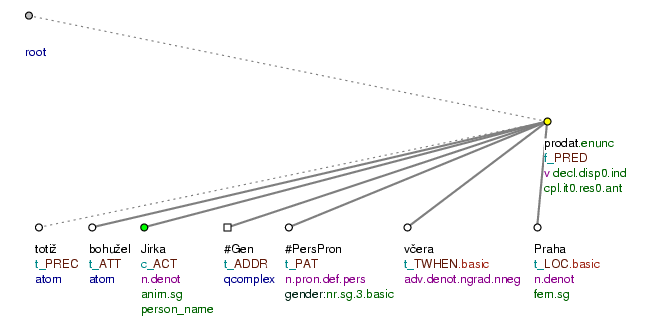In this section we describe guidelines for the ordering of sister nodes representing contextually bound and non-bound expressions whose governing node is a node representing a verb (both finite and non-finite). They apply mainly do nodes dependent on the effective roots of both subordinate and main verbal clauses (see Section 4, "Verbal and non-verbal clauses").
Nodes representing contextually non-bound expressions (nodes with the value f in the attribute tfa) are ordered according to the surface word order, so that potential deviations from the systemic ordering can be easily detected and their causes studied.
Exception: The only exception is the focus proper node. If the focus proper is immediately dependent on the verb, its node is always placed rightmost in the underlying order, even though it is at a different position in the surface structure (see also Section 3.1.1, "Focus proper").
The communicative dynamism of (both contrastive and non-contrastive) contextually bound expressions is modified according to the context, it need not correspond to the systemic ordering. The degree of communicative dynamism of the expressions is usually determined by their function in the topic-focus articulation. The function is signaled through diverse means - word order, syntactic function, intonation and others. According to them we distinguish types of contextually bound nodes (i.e. nodes with the value t or c in the attribute tfa). Below we propose their assumed order according to increasing communicative dynamism.
In the tectogrammatical trees, contextually bound nodes are ordered from left to right as follows:
-
nodes representing the vocative, i.e. nodes with functor
VOCAT(if present in the construction), -
nodes with the functor
PREC, -
nodes with the functor
ATT, -
nodes representing rhematizers (
functor=RHEM), if there is a contrastive contextually bound node in their scope, -
contrastive contextually bound node,
-
other expressed (non-contrastive) contextually bound nodes, with the exception of nodes of types 8 - 9 below,
-
newly established nodes (representing expressions absent in the surface structure of the sentence),
-
expressed nodes with the t-lemma substitute
#PersPron, -
expressed locative and temporal modifications which are non-contrastive.
If there are several nodes within one type (1 - 9), we order them according to the surface word order.
Compare:
-
Jirka ho totiž bohužel včera v Praze {
#Gen.ADDR} prodal. (=lit. George it.ACC in_fact unfortunately yesterday in Prague sold.)The contextually bound expressions are represented by sister nodes in the following order:
-
the node with the functor
PRECrepresenting the expression totiž (=in_fact), -
the node with the functor
ATTrepresenting the expression bohužel (=unfortunately), -
the contrastive contextually bound node representing the expression Jirka (=George),
-
the newly established node representing the non-expressed Addresse,
-
the expressed node with the t-lemma substitute
#PersPronrepresenting the pronoun ho (=it.ACC), -
the node representing the temporal modification včera (=yesterday),
-
the node representing the locative modification v Praze (=in Prague).
Compare Fig. 10.10.
-
